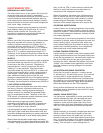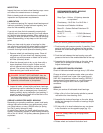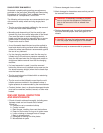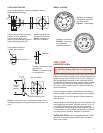
INSPECTION
I
nspect the inner and outer wheel bearing cups, cones
and rollers for excessive wear or damage.
Refer to bearing and axle manufacturer’s manuals for
inspection and replacement requirements.
LUBRICATION
For maximum bearing life, inspect wheel bearings and
lubricant periodically, change lubricant regularly, and
clean the hub assembly properly.
If you do not clean the hub assembly properly both
originally and in subsequent service, you must adhere
to a shorter lube change schedule. When adding oil or
checking oil level, be certain to clean the cap and plug
before disassembling, to help keep out dirt and road
grime.
When you clean and dry parts or bearings for later
use, pack and coat them with wheel bearing lubricant
and wrap in clean waxed paper to prevent surface
corrosion that might cause premature bearing failure.
1. Remove wheel hub and bearing cones. Clean all
old grease or oil from wheel hub, bearing cones,
and hub cap with kerosene or diesel fuel oil and a
stiff fiber (not steel) brush.
2. Allow the cleaned parts to dry, or dry them with a
clean absorbent cloth or paper. Grease and oil
will not adhere to and protect a surface wet with
solvent. The solvent may dilute the lubricant.
Clean and dry your hands and all tools.
3. Inspect oil seals, oil seal wiping surfaces, bearings,
and bearing cups for indications of wear or damage.
Replace any worn or damaged parts. Handle the
bearing carefully during inspection (and packing, if
grease is used) so the cage will not be bent or the
rollers and cone damaged.
GREASE-LUBRICATED WHEEL BEARING
Depending on operating conditions, speed, and loads,
change lubricants whenever you replace seals, when
you reline brakes, or every 100,000 miles (or Spring
and Fall if yearly mileage is less).
At rebuild time, before you install wheel bearings onto
spindle, coat bearing journals (to deter fretting corrosion)
with a film of Lithium, 12-Hydroxy stearate grease or its
equivalent.
When you service grease-lubricated wheel bearings:
1. Pack bearing with pressure packer, if possible. If not,
pack by hand, forcing the grease into the cavities
between the rollers and cage from the large end of
the cone.
2. Pack the hub between the two bearing cups with
grease to the level of the smallest diameter of the cup.
3. Assemble the hub and bearings on the axle, being
careful not to damage the oil seals or bearing.
Adjust the bearings.
OIL-LUBRICATED WHEEL BEARING
Check oil-lubricated wheel bearings every 1,000 miles.
Change oil when you replace seals, when you reline
brakes, or at least once a year. Use a gear-type oil:
SAE 140 if temperature is above freezing, SAE 90 if
temperature is below freezing, or a multipurpose oil
with an SAE range of 85 to 140 for year-round
conditions.
SERVICE
When you service oil-lubricated wheel bearings:
1. Wipe a film of oil on the bearing spindle to prevent
rust behind the inner bearing cone.
2. Assemble the hub and bearings on the axle, being
careful not damage the oil seals or bearings. Adjust
the bearings.
3. Fill hub with oil to level indicated on cap, as shown
in the illustration on the opposite page (pg. 13).
4. Rotate wheel and recheck lubrication level.
DANGER DO NOT USE GASOLINE. Also, do
not clean these parts in a hot solution tank or
with water and alkaline solutions such as sodium
hydroxide, orthosilicates or phosphates.
NOTICE: Always clean cap and plug before
reassembly.
R
ECOMMENDED WHEEL BEARING
GREASE SPECIFICATIONS
Soap Type – Lithium, 12-Hydroxy stearate
or equivalent.
Consistency – NLGI No. 2 or NLGI No. 1
Corrosion and Oxidation Inhibitors
Base Oil – Solvent Refined Petroleum Oil
Base Oil Viscosity
at 210˚ F. . . . . . . . . . . . . 75 SUS (Minimum)
Pour Point . . . . . . . . . . . + 10˚ F. (Maximum)
12


















